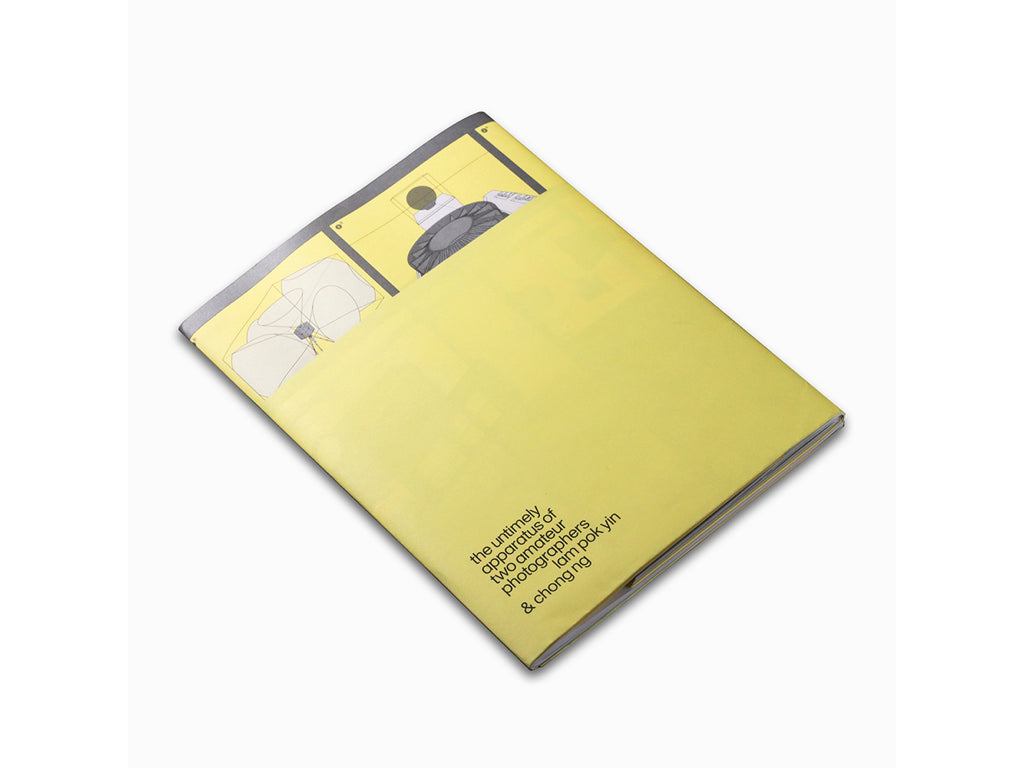














初版600部
Jiazazhi Press発行
Shortlisted by 2019 Paris Photo-Aperture First Book Award
About the book
ただ、カメラは中立的に見える。なぜなら、私たちは皆、カメラの設計者や製造者が手に届く前に下した決定を無視しているからである。私たちはカメラの中で起こるプロセスを知らず、3次元の現実がどのように2次元のプリント、すなわちデジタルデータに縮小されるかを正確に知らないので、現実をイメージに変換することは直接的に見える。カメラは、イメージが意味を持つようにコード化される方法に大きな役割を果たします。カメラは写真を作成するようにプログラムされており、すべての写真はカメラのプログラムに含まれる可能性の1つを実現している。
画像制作の過程や装置が秘匿されるにつれて、自由の拡大と思われるものは、おそらく、技術的な映像に対する批判に関与する方法がない限り、写真を通して新しい物語がどのように創造されるかを制限するものであるとも言える。
本作は、2人のアマチュア写真家の手によって装置、方法論、画像形成プロセスを入念に調べることによって、写真の基本的な要素を分解し、再考する試みとなっている。
演出されたパフォーマンスや入念なプロセスを通じて、写真を取り巻く規範や想定されていた思想が崩壊し始めるまで極限に達し、時代遅れの技術や日常的な物体が再発明され、適応され、急進化される。「古風な」プロセスと旧式のデバイスを使用するという決定は、ノスタルジックなものや感傷的なものではなく、むしろそれらが、私たちに見過ごされたメカニズムや画像作成におけるカメラの役割を詳述するための柔軟性と能力を提供するという認識である。この考え方は、カメラのマニュアルに書かれていた写真用語を破壊的に使用することによってさらに確立された。本書では、カメラ操作者である私たちが、実際にこれらの機器をハッキングし、本来の用途を侵害し、新たな目的を果たすようにしているときに、前述の機器の正しい使い方を示しているように見えるだろう。
私たちが使っている「カメラ」とは、果たして本当はどういう存在なのだろうか。
ー
The prevalence of digital cameras has made image making frictionless and photography has become more affordable and seemingly democratic than ever. However, at the same time, as the camera turns more automatic and intuitive in use, its operation and the predetermined programs within it are more concealed from the users. After all, reality does not just get flattened into an image objectively. Cameras look neutral, because we are all ignorant of the decisions that were made by the designers and manufacturers of the cameras before they reach our hands. The translation of reality into image seems direct because we are ignorant of the process that happens inside the cameras, unaware of exactly how 3-dimensional reality is reduced into a 2- dimension print, or digital data. Cameras play an enormous part in how images are encoded with meaning. The camera is programmed to produce photographs, and every photograph is a realisation of one of the possibilities contained within the program of the camera.
As image-making processes and apparatus become more concealed, what appears to be an expansion of freedom is probably a restriction of how new narratives could be created through photography, for as long as there is no way of engaging in such criticism of technical images, we shall remain illiterate.
Thus, this project becomes an attempt to deconstruct and rethink the fundamental elements of photography through looking at the apparatus, methodologies and the image-making process through the hands of two amateur photographers. Through staged performances and elaborate processes, norms and presupposed ideas surrounding photography are taken to the extreme until they begin to fall apart. Obsolete technologies and everyday objects are reinvented, adapted and radicalised. The decision to use “archaic” processes and obsolete devices is not a nostalgic or sentimental one, but rather a realisation that they offer the flexibility and ability for us to elaborate on overlooked mechanisms and the role of the camera in the making of images. This idea is further established through the subverted use of the photographic language from camera manuals. In these instructional images, we, the camera operators, seem to be demonstrating the correct use of the aforementioned apparatus, when actually, we are hacking these devices, violating their original uses, and making them to serve a new purpose.
